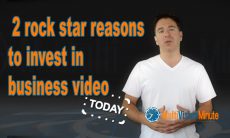How do we optimize biddable media where almost no consumers click on ads and even fewer purchase directly from clicking on an ad?
Biddable media and story telling
In order to optimize biddable media our role is to align the brand with things that matter to the consumer. And these things are different for different markets, audiences, and groups. In order to increase the value of biddable media and at the same time to optimize their use, we as the AGENCY must not only understand the brand, but also interpret the communication people have with the brand–the feeling and reactions to the brand’s activities.
We have to train the brand that we can’t face our times using old techniques.
Massive spending isn’t the key to great results online. Connectivity is–and connectivity requires disclosure. Most of us have no problem with connecting as long as we are able to enjoy something which makes our lives just a little better.
The creative component of native advertising is content marketing, i.e., messaging intended to attract rather than interrupt consumers. Paid placement for attractive content aims to buck the twin trends of banner blindness and shrinking ad revenues.
Early results are highly preliminary, but promising. Facebook Page Post ads generate 49 times more clicks at 45 percent less cost; and according to Nielsen, a Promoted Tweet impression drove a 22% average increase in message association compared to users not exposed to Promoted Tweets.
eMarketer predicts spending on native advertising will nearly double by 2017 in the U.S. So, we have to work on finding ways not only say the right story but also we have to place the story where people are ready and thrilled to make our story their story, our messages part of their timeline, our ads something they really want to watch, to have.
Behavioral Mapping
The behavior graph provides the foundation, to some extent, of Google Search, Netflix recommendations, Amazon recommendations, iTunes Genius, Nike+ run tracking, Foursquare, Fit Bit, and the entire “quantified self” movement.
We need to put in place a foundational content strategy prior to native advertising (or content marketing) executions.
We have to master each platform with its own unique user base, formal structure, native behaviors, and social actions. For example, Facebook emphasizes reach and engagement over metrics like “People Talking About This” and “Likes,” with their goal being to speak the same language that marketers use in other channels.
A tweet is fleeting, while a Pinterest pin lasts until the owner of the account takes it down. In addition, tracking elements, calls to action, and other measurable elements can track the ROI of native advertising campaigns. While these techniques have been underutilized to date, they will become common in the near future.
There is, therefore, no doubt that coordinating the content of ads to consumer interests increases advertising effectiveness.
This matching can be achieved by two methods, either by targeting pages that contain content liked by the user or by analyzing content browsed by a user to determine his/her interests, and then present matching advertisements while he/she is browsing. This last method is legislated, and caution is advised for publishers, advertisers and distribution networks.
We have to chart also how people behave and interact with offline elements aligned or not to the brand–not only the right time slots but also the emotional and daily activities of our audience.
We have to avoid overlaps, but at the same time, we have to create a consistent interaction between people and brand.
We must use Big Data in order to chart the daily journey of the aimed market group. To understand, to identify emotional elements in this, and most significantly to try mapping how people change behavior after coming in contact with the brand and the running campaign. That would allow us to bid the right media on the right time avoiding overlap.
Measurement
We need to develop Key Performance Indicators (KPIs) for each native advertising campaign to serve as a baseline and to understand that it’s perfectly permissible for these basic goals to change, but without basic metrics, optimization and insights won’t be possible. At the same time we have to use caution with overly publisher-centric metrics — such as traffic, engagement, and time spent on page — that gauge campaign effectiveness.
While publishers are currently using these benchmarks to measure native advertising effectiveness, they rarely correlate with real brand objectives: measuring native advertising effectiveness against a converged paid-owned-earned media model, encompasses social listening and monitoring (often in real or near real time), and social measurement. More than other forms of advertising, native does not live in a vacuum, but must be measured against other channels of paid, owned, and earned media
Conclusion
In conclusion, our mission is to make the brand the connector, and the vehicle to make people flow. Biddable media is there to not only drive consumers/users/people to buy branded products but also to be part of what the brand means for them.
The best way to do so is to not push people buy products but live and share moments in the world where things happen either for FIRST time or each time has the excitement of the FIRST time.




